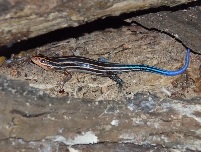Broad-Headed Skink (Plestiodon laticeps)
Description: Together with the Great Plains skink it is the largest of the "Plestiodon skinks", growing from a total length of 5.9 inches to 13 inches. The broad-headed skink gets its name from the wide jaws, giving the head a triangular appearance. Adult males are brown or olive brown in color and have bright orange heads during the mating season in spring. Females have five light stripes running down the back and the tail, similar to the Five-lined Skink. However, they can be distinguished by having five labial scales around the mouth, whereas Five-lined skinks have only four. Juveniles are dark brown or black and also striped and have blue tails.
Habitat: Broad-headed skinks are semi-arboreal lizards that are strongly associated with live oak trees. It does not appear that the lizards have a preference for tree size, rather they prefer trees with holes. Juveniles stay closer to the ground on low or fallen branches. Males have been known to guard preferred trees that are surrounded with dense brushes to limit attack by predators and harbor prey. Dead and decaying trees are important habitat resources for nesting.
Range: Broad-headed skinks are widely distributed in the southeastern states of the United States, from the East Coast to Kansas and eastern Texas and from Ohio to the Gulf Coast.
Diet: Broad-headed skinks eat mainly insects, spiders and other invertebrates, but will also eat mollusks, rodents and small reptiles, including juveniles of their own species. They find food through visual and chemical signals which they can detect by flicking their tongues.
Reproduction: Males typically are larger than females. The larger the female, the more eggs she will lay. Males thus often try to mate with the largest female they can find, and they sometimes engage in severe fights with other males over access to a female. Females will also mate with the largest males they can find, a result of the Good Genes Hypothesis. Females emit a pheromone from glands in the base of the tail when they are sexually receptive and males can find them by tracking their chemical trails through tongue-flicking. Males show higher tongue flicking rates when exposed to conspecific females verses heterospecific females when mating and will terminate behavioral interaction without initiating courtship if the pheromones do not match the species. The female lays between 8 and 22 eggs, which she guards and protects until they hatch in June or July. Female broadhead skinks will lay their clutch in decaying log cavities, and they have been observed to create a sort of nest by packing down debris within their cavities. The hatchlings have a total length of 2.4 inches to 3.1 inches.
Status: Listed as Least Concern in view of its wide distribution, tolerance of a degree of habitat modification, presumed large population, and because it is unlikely to be declining fast enough to qualify for listing in a more threatened category.
»» Kingdom: Animalia - Animals
»» Phylum: Chordata - Chordates
»» Subphylum: Vertebrata - Vertebrates
»» Class: Reptilia - Reptiles
»» Order: Squamata - Lizards
»» Family: Scincidae - Skinks
»» Genus: Plestiodon
»» Species: Plestiodon laticeps - Broad-Headed Skink
»» Subspecies: None
This article uses material from the Wikipedia article "Plestiodon laticeps", which is released under the Creative Commons Attribution-Share-Alike License 3.0. Content may have been omitted from the original, but no content has been changed or extended.
|








